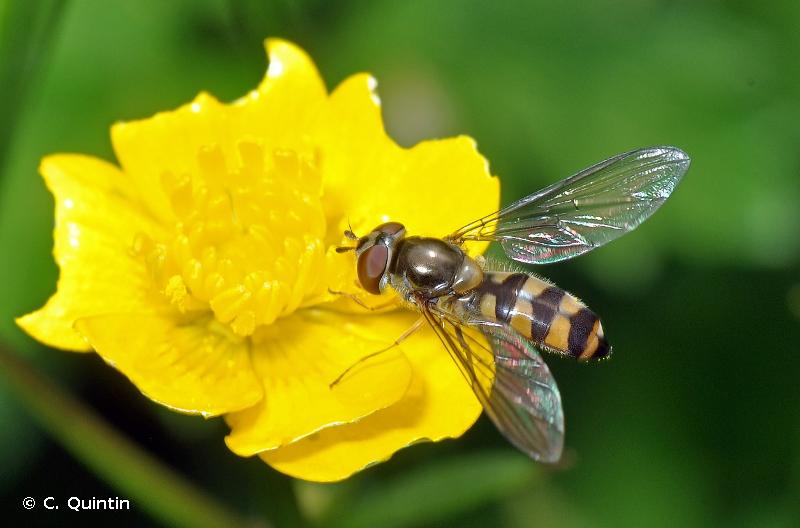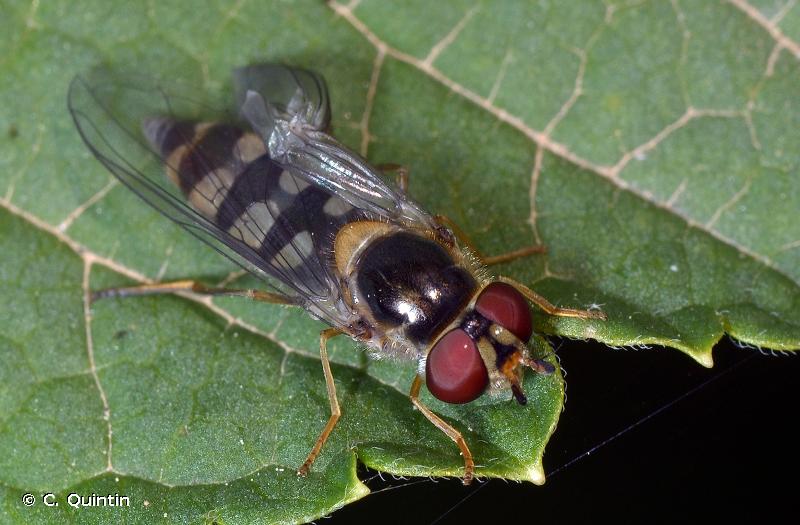
cd_nom

| Author : C. Quintin |
 |
To get the picture, please visit:
Christophe Quintin
email : inpn@mnhn.fr
Despite the Creative Commons license, please inform the author of the use which will be made of his photo

| Author : C. Quintin |
 |
To get the picture, please visit:
Christophe Quintin
email : inpn@mnhn.fr
Despite the Creative Commons license, please inform the author of the use which will be made of his photo
Taille :
Petite, 8 à 11mm.
Diagnose :
Cette espèce fait partie de la sous famille des Syrphinae, elle a donc les callus huméraux glabres. On la reconnaît grâce à ses petites sclérifications sur le bord postérieur de son aile et le mésapisternite antérieur (partie latérale du thorax) qui comporte quelques poils bien développés. Elle se distingue des autres espèces par des taches jaunes grisâtres sur les segments abdominaux et la lunule (partie de la tête à la base des antennes) est jaune chez cette espèce.
Facilité d'identification :
Relativement facile, la détermination peut se faire sur photo.
Confusions possibles :
Confusion possible Meliscaeva cinctella et dans une moindre mesure Meligramma cincta.
Période de vol:
Les adultes sont visibles de mai à octobre en plusieurs générations successives. Ils hivernent et il est donc possible de les trouver en hiver lors de très belles journées dans les endroits ensoleillés.
Répartition générale:
Cette espèce est présente de la Scandinavie jusqu'à la péninsule ibérique, au pourtour méditerranéen y compris l'Afrique du Nord, la Turquie et Israël ainsi que les îles (Chypre, Malte, Crète). On la retrouve sur les îles britanniques à travers pratiquement toute l'Europe et jusque dans les parties européennes de la Russie.
Habitat et biologie:
C'est une espèce forestière que l'on rencontre dans de nombreux types de forêts de feuillus et de conifères, qu'elles soit naturelles ou plantées. Les adultes sont largement arboricoles et s'observent sur le feuillage des arbres, les mâles sont observables en vol stationnaire en lisière ou dans les chemins forestiers généralement à plus de 2 mètres au dessus du sol. Les larves sont des prédatrices des pucerons que l'on peut trouver sur une grande variété de végétaux, à la fois des arbres, des arbustes et des herbacées (y compris des plantes cultivées). Elle a également été observée en train de se nourrir de Psyllidae sur des oliviers.
Speight, M.C.D. (2020) Species accounts of European Syrphidae, 2020. Syrph the Net, the database of European Syrphidae (Diptera), vol. 104, 314 pp., Syrph the Net publications, Dublin.
Thomas Lebard(),2021
Continental
Metropolitan France
Overseas
Marine
Metropolitan France
Overseas
The map presents a summary at the 10 x 10 km grid of the observation data for the species transmitted to the SINP. These data have been subjected to validation filters.
The map presents a reference distribution layer of the species at the scale of departments and marine sectors. The presence and absence data were established by expertise within a network of partners. This reference distribution is used in the validation process of the SINP data at the INPN level.
Corresponds to a report on the basis of at least one observation proved within a period of 10 years (20 years for little-known invertebrates) preceding the year and no presumption of extinction since obtaining the last data nor doubt on reproductive and implemented nature of this population. For migratory species, the presence indicated concerns areas of reproduction.
This status is based on one or more of the following criteria:
This point covers the absence, more difficult by nature to demonstrate than presence. This status is based on one or more of the following criteria:
This status must be assigned to a department in which the presence of the species is casual.
Particular case of absence due to a proven extinction less than a half century ago (older disappearances are treated as "no probable or definite").
In the state of knowledge, we can not comment on the presence or absence in the current department. This is the default status when not comprised in one of the previous categories or whenever there is doubt.
The map shows the global distribution of the species based on GBIF data (Global Biodiversity Information Facility).
